Goldwork is called “goldwork” because it involves the use of gold threads. The term goldwork is often used interchangeably with “metal thread embroidery,” though metal thread embroidery encompasses the use of more than just gold threads. It pretty much takes into account the use of any metal threads. The gold threads involved in goldwork are not “metallic” threads, but are rather “real metal threads” – gold, silver, and alloys – that are used (often in combination with silk) to produce the richest results in hand embroidery.
Real metal threads today come in a variety of colors, and these can be used to produce some interesting effects in metal thread embroidery. I haven’t done any real work with colored metal threads beyond playing with them, but I’ve recently gotten my grimy paws on a few new pieces of colored metal threads, and my mind is whirling with The Possibilities! I suppose I’m a bit like a crow that way. I just love sparklies!
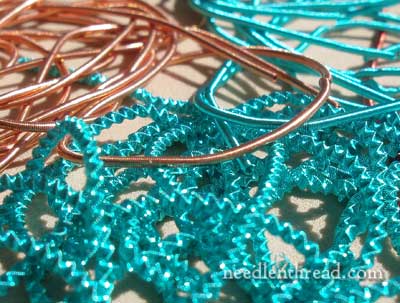
These are purls. They’re metal threads made from wire, and they look like a very fine spring with a hollow core. Unlike a spring, though, they don’t bounce back when they’re stretched. There are different types of purls used in goldwork and metal thread embroidery: smooth purl, rough purl, and check purl, for example. What’s the difference between the three? Smooth and rough purl are pretty much the same, except that smooth purl is really shiny, while rough purl has a matte finish. Check purl, though, is crimped in such a way that the spring is faceted. The sparkly turquoise thread in the lower half of the above is check purl.
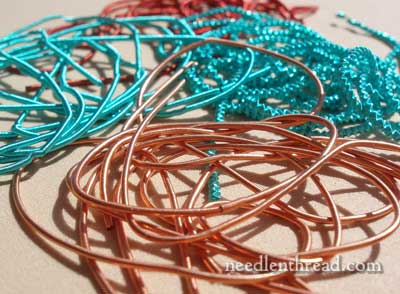
I love purl! In its “smooth” and “rough” forms, it tends to look a lot like wiggly spaghetti!
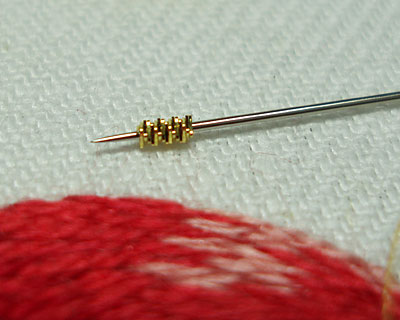
Purl is cut into pieces (called “chips”) and sewn on like beads. Last year, I used a bit of check purl on this goldwork pomegranate design. There are different ways of using purls – they can be cut into little bits and used to fill a space…
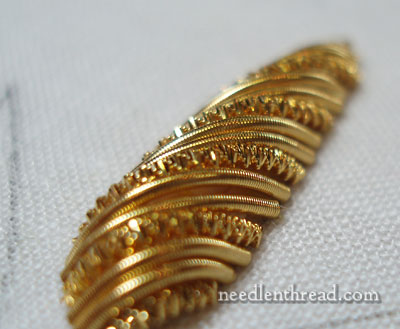
… or they can be used in long pieces over raised padding. (My spacing is Really Off on those bits in the photo above. I need to take a couple of those off, trim them down to size and replace them!)
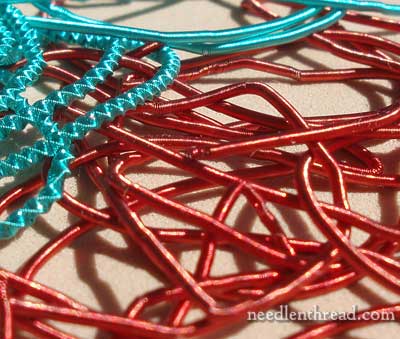
But back to the whole color question: metal threads are available in a slew of colors. No, not quite as many colors as you’d find in your typical line of embroidery threads! But still, there’s a nice selection of colors available out there – from blues, to purples to reds, orange, and green, copper, and even black. You can also find a variety of colored metal passing thread out there, and even pearl purl in colors. So if you want to add some color interest to your metal thread embroidery, track down some colored metal threads!
You’ll find colored metal threads at shops that carry supplies for goldwork, which are rather few and far between. However, there are some good online resources if you don’t live near such a shop (I don’t!). In the US, you can try Threadneedle Street, and Fireside Stitchery for metal threads. In Canada, Berlin Embroidery carries them. In Australia, try Alison Cole Embroidery and Mary Brown Designs. In the UK, you can try Golden Hinde and Golden Threads.
Finally, today’s the last day you can sign up for my Birthday Give-Away – your opportunity to win a very nice needlepainting kit, some Evertite stretcher bar frames, and a lovely pair of perfect DOVO embroidery scissors. If you haven’t signed up yet, don’t forget! Thanks to all who have participated so far, and for you kind wishes for my birthday. I realized only after the fact that it seemed like a really an underhanded way for me to get over 600 people to wish me a happy birthday!
Later on this week, I’ll be showing you a piece of Suzhou embroidery up close and personal. I’m still trying to finish up a couple beginner tutorials (!), and I’ll also be sharing with you a very pretty Hungarian embroidery design from Lilly’s Legacy – one intended for whitework, but with many applications. Somewhere in there, I’d like to give you some project updates (slow going – busy days at work!), and show you some silk threads and a new positively gorgeous thread collection on the market. Oh, I’ve got LOTS to share with you in the next couple weeks! I’m looking forward to it and I hope you are, too!


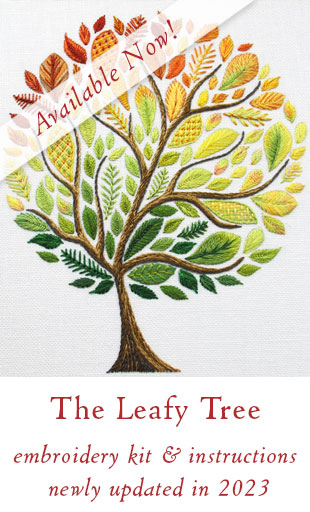
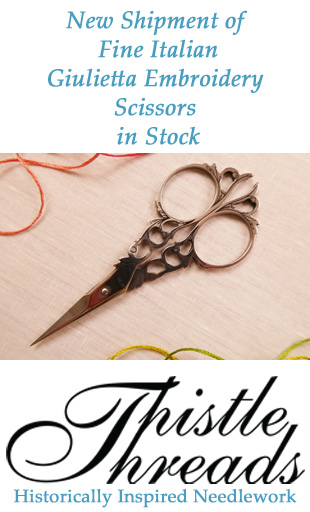
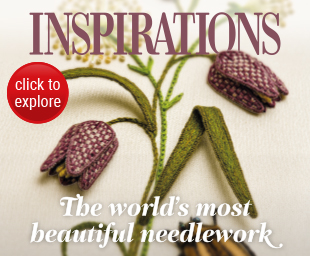

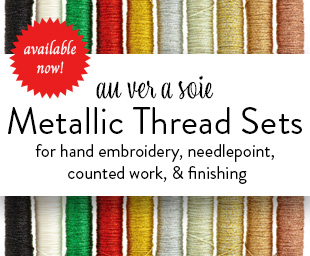
Hi Mary,
Thanks for teaching me so much. I’ve read your gold work articles before (more than once)and I always learn something more or understand something a little better,the picture is a little more clear. Thanks for being a great teacher. I hope you did something fun for your birthday weekend!
Ah, you’re speaking to my heart – sparkles, sparkles and more sparkles. I have a bad habit of trying to incorporate some kind of metallic into my work. A few times I’ve gotten carried away and it didn’t look so great. LOL
A beginner’s question: I’ve never used the gold purl. I’ve seen you use chips on your work. Can you use regular embroidery thread with the chips or will they eventually cut through the floss/thread?
Keep up the good work and writing. You can talk about sparkles any time.
Hi, Irene – I generally use a silk couching thread, waxed, for sewing down chips (usually Soie 100/3 by Au Ver a Soie and sometimes Tire Silk – just depends on what I have on hand). You can also use Guttermann’s polyester sewing thread. In any case, the thread is usually waxed (with beeswax) before you start sewing down the chips. Hope that helps! ~MC
I think sparkles appeal to the princess in all of us! I was already intrigued about Goldwork having read previous posts on your site, now it’s definitely no.1 on my wish list. Isn’t it wonderful that there is always something new to learn whether it’s about stitching or life itself!
Since I am one of those 600 well wishers I just wanted to say if you should draw my name I will be willing to share and you may draw two other names also and I will share my winnnings. And 600 well wishers…if that many people hit my blog I’d think I”d been spammed! Congratulations again on your bithday.
OMG–is that aqua colored check purl?!? WOW Checking the three US suppliers, I didn’t see it offered. Did you order it from abroad? Would love to know. A few years ago RSN had pearl purl in a bazillion colors (mine is lavender) but not the check. As I recall, it was sourced from India. BTW–is this a good time to inquire about sources for fancy paillettes? My collection includes: 4-leaf clover shape, bi-color (silver/gold), gold with pie-crust edges etc. They were purchased in the US from a person who said they came from France & I’ve never seen anything like them since. I would love to add to the stash, although colored check would be a good start!
Thanks for the links! My first thought when I saw the pic was “oh, pretty — I wonder where I can get that”. I absolutely must try goldwork soon! Using gold-coloured threads or other colours like these.
As a beader I’m actually a bit familiar with french wire/bullion/gimp, which kind of is the same thing as purl and used to cover beading wire or pearl silk when finishing a necklace.
hi Mary,
this is the only thing we disagree on. i have never been a sparklie person. i have enjoyed watching you do your goldwork. it is just not something i would ever choose to do. my husband did not want us to have yellow gold wedding rings so we got white gold. they are a lot more understated. the small amount of jewelry i have collected during our 30 years of marriage has mostly been sterling silver and if any precious stones they have been pearls. no sparklies! your pommegranette was beautful though. i truly loved it. this was after just seeing goldwork from the two magazines from down under. everything i had seen had been done completely in metal threads.
Mary, your’s had color! since you did your’s they have published two with threads other than metal. they didn’t hold a light to the one you designed. so i want to thank you here and now for showing me that goldwork can indeed be beautiful!
I love metal threads! I have a whole stack of coloured check purl in lime green and black in preperation for a piece I’m going to do with bits of old circuitboard and lots of green and black sparklies of all kinds. The actual execution is still very fuzzy as I have yet to design it, but the colour palette is definitely there!
Dear Mary,
I was reading through some previous posts. On this one, the link “metal passing thread” points to http://dev.needlenthread.com/2010/03/goldwork-embroidery-smooth-passing.html
Ages ago, you explained about the “dev” links but the information may have got lost about removing the “dev”. Is it worth correcting the link?
Your website is well-designed and has stood up well over the years. I am very appreciative of it and of your efforts
Thanks, Helen! I just fixed it – I appreciate your letting me know!